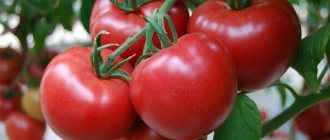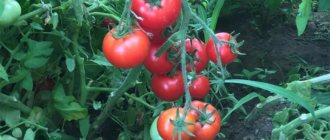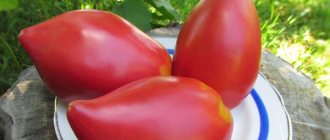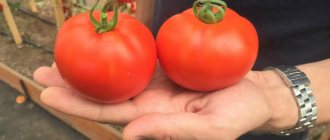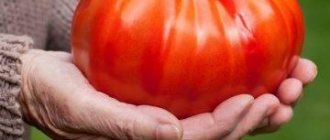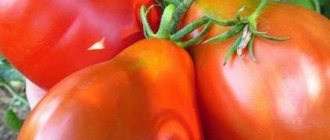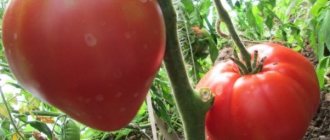Description of the variety
This variety is classified as a mid-season tomato - about 3.5 months pass from the moment the seed material germinates until the ripe tomatoes are harvested. The Chelyabinsk meteorite tomato is a determinant type; its stems stop developing at a certain height. In this case, on the central shoot at the top, not foliage is formed, but an inflorescence with buds, so the stem does not grow further.
The height of the central stem can reach 1.2-1.5 m. And simple inflorescences are usually formed in the axils of the leaves, the first of them is formed above 4-5 permanent leaves, and each subsequent one is formed after two leaves.
Related article:
Early ripening tomato variety Raja
Each inflorescence usually produces 5-8 ovaries. The weight of ripened tomatoes is 85-95 g, their shape is round. The skin is compacted, not prone to cracking, bright red in color, with a yellowish tint. The pulp of these tomatoes is quite fleshy, with 5 seed chambers. The amount of seeds and liquid in them is small.
The taste of these tomatoes is sweet, with virtually no sourness.
Characteristics of the variety
The plant of the Chelyabinsk meteorite variety is a hybrid, so you cannot collect the seeds yourself for next year: the crop will lose its grade.
Description of the bush
According to the description given by the seed manufacturer, the bush has the following characteristics:
- medium-sized - height reaches 120-150 cm, when cultivated in protected soil it grows up to 180 cm;
- the foliage is average, the shape of the leaf blades is interesting, which are similar to potato ones;
- bushes require gartering, pinching and shaping.
Description of fruits
Chelyabinsk meteorite tomatoes have the following characteristics:
- round vegetables;
- the peel is smooth and elastic;
- the color of fruits in a state of biological maturity is deep red;
- the weight of one specimen ranges from 50 to 90 g;
- The taste of tomatoes is bright with barely noticeable sourness, the vegetables are juicy and aromatic.
Productivity and fruiting
The timing of fruiting depends on the region of cultivation, on average it occurs in July. When cultivated in a greenhouse, this period begins earlier. The formation of the ovary and ripening of the fruit takes a long time and ends before the onset of autumn frosts.
Yield indicators, according to the characteristics of tomatoes, are influenced by compliance with the basic rules for caring for the crop. Under suitable conditions, 12-13 kg of full-fledged fruits are collected from 1 m², so the variety is classified as high-yielding.
Application area
According to the description, Chelyabinsk meteorite tomatoes are distinguished by their versatility of use. They are used fresh, for preparing salads and snacks, and are also suitable for winter preservation.
The dense skin of the fruits, which prevents them from cracking under the influence of heat treatment, their small size allows them to be pickled and salted as a whole. Hybrids are often used to prepare sauces, pastes, and juice.
Resistance to diseases and pests
Tomato Chelyabinsk meteorite f1 is resistant to the main diseases and pests that tomatoes are often exposed to. If you follow the rules of care and take preventive measures, the crop will be protected from these negative factors.
Growing regions
In the southern regions of the country, as well as in central Russia, the cultivation of the Chelyabinsk meteorite variety is practiced in open ground. In Siberia, the Urals (in particular in Chelyabinsk), in the Krasnoyarsk and Amur regions, where weather conditions are harsh, tomatoes are grown exclusively using the greenhouse method.
In the Urals, the variety is recommended to be grown in a greenhouse
With the right growing method, the variety is suitable for cultivation anywhere in the country.
Productivity
The yield of the Chelyabinsk meteorite tomato is average; at least 4 kg of ripe produce is harvested from one bush per season. To harvest such a harvest, the bushes should be formed correctly - no more than 3 stems. You should also avoid loading the bush with crops, so it is recommended to leave no more than 10 clusters with ovaries on the bushes, and remove the rest manually.
Related article:
Fertilizers for tomatoes
Positive and negative aspects of the species
The properties of the Chelyabinsk meteorite tomatoes, both positive and negative, help the summer resident decide whether to breed the species or not.
- Stress resistance. The plant easily survives any unfavorable conditions. Without affecting the formation of fruits.
- Fruiting is constant and stable.
- Unpretentious. Feels equally good under the scorching rays of the sun, with a lack of moisture and more.
- Compactness. Helps to save space on the site.
- High cost of seed material.
- It will not be possible to prepare seeds for next year. The collected seeds of hybrids sometimes do not even sprout.
Diseases and pests
If the soil in the greenhouse is too wet, then tomatoes of this variety may be affected by fungal diseases. At the first symptoms of diseases (the appearance of dark spots on foliage or stems, or white plaque), it is necessary to treat tomatoes with copper-containing preparations or appropriate fungicidal agents.
Related article:
So that there are more tomatoes than greens on them
To prevent the occurrence of such diseases, it is necessary to ventilate greenhouses after watering and monitor soil moisture.
The following pests may appear on tomato bushes:
- aphid;
- gall midge;
- whitefly;
- scoop;
- slugs
If the number of pests is small, they can be dealt with using folk remedies: infusions based on red pepper, onion peels, and wood ash. If the pest colony is too large, then insecticidal preparations have to be used.
Disease susceptibility
Growing Chelyabinsk meteorite tomatoes does not cause problems. Since they suffer little from various diseases. They are resistant to almost everything except blackleg. It mainly affects young plants. It is rare for a plant to become infected with late blight.
- Colorado beetle.
- Whitefly.
- Melon aphid.
- Spider mite.
- Medvedka.
You can fight them using chemicals, strictly following the instructions.
Advantages of the variety
The main positive qualities of the Chelyabinsk meteorite tomato include:
- good yield;
- the possibility of growing in regions with difficult climatic conditions;
- wonderful taste of ripe fruits;
- versatility of the harvested crop;
- bushes are resistant to stressful situations;
- ovaries are formed in any weather conditions.
Description of tomato Chelyabinsk meteorite
Information about the Chelyabinsk meteorite variety has been present in the state register since 2015. It can be grown in all regions of Russia. The author is the famous breeder Myazina L.A. Tomatoes ripen early. The plant is determinate, 150–180 cm high. The leaves are dark green, large, reminiscent of potato tops. Inflorescences of a simple type. Tomatoes ripen in clusters of 5–7 pieces.
Description of fruits
Description of tomato fruits of the Chelyabinsk meteorite variety:
- flat-round shape;
- medium density pulp;
- orange-red color;
- weight up to 300 g;
- number of nests from 4 to 6;
- good sweet taste.
Characteristics of the variety
Before choosing tomatoes for planting, it is important to take into account all the characteristics of the variety. Pay attention to the timing of fruiting, yield, resistance to diseases and climatic factors.
Productivity and fruiting
Tomatoes of the Chelyabinsk meteorite variety ripen early: at the beginning and end of July. Fruiting is extended, until the onset of frost.
According to the description, Chelyabinsk meteorite tomatoes yield 12–12.5 kg per 1 sq. m. Productivity per plant is about 4 kg. The variety is planted in greenhouses and open areas. Watering and fertilizing have a positive effect on fruiting. Tomatoes are resistant to adverse conditions and form ovaries even in cold and rainy weather.
Area of application of fruits
The purpose of the fruit is universal. They are used fresh in cooking. Thanks to their thick skin and medium size, tomatoes are suitable for pickling and pickling for the winter.
Resistance to diseases and pests
The variety is resistant to major diseases and crop pests. Requires preventive treatments and adherence to agricultural technology.
Advantages and disadvantages of the variety
The tomato variety Chelyabinsk meteorite has a number of positive characteristics:
- early maturation;
- high productivity;
- presentation of the fruit;
- resistance to adverse conditions, diseases and pests;
- good taste.
The variety has no obvious disadvantages. High humidity may cause the fruit to crack.
Landing
This variety of tomatoes is grown in seedlings. At home, seed material is planted in specially prepared soil and the emerging sprouts are provided with proper care.
Growing seedlings of this variety of tomatoes is no different from growing seedlings of other varieties and hybrids of tomatoes. The main thing when caring for growing tomatoes is to follow the watering regime, pick seedlings and apply a couple of fertilizers so that the seedlings grow strong.
Obtaining seedlings
The Chelyabinsk meteorite tomato variety is grown in seedlings. Seeds are planted at home. After germination, the tomatoes are provided with the necessary temperature conditions and other care.
Preparatory stage
Tomatoes are planted in prepared soil obtained from fertile soil and humus. You can prepare it yourself or purchase soil mixture at a gardening store. It is convenient to plant tomatoes in peat tablets. Then 2-3 seeds are placed in each of them, and after they germinate, the strongest tomatoes are left.
Before planting, the soil is treated by exposure to high temperatures. It is placed in a microwave or oven. The soil is steamed for 15-20 minutes to disinfect. Another treatment option is to water the soil with a solution of potassium permanganate.
Advice! To improve the germination of tomato seeds, the Chelyabinsk meteorite is placed in warm water for 2 days.
If there is a colored shell, the seeds do not need to be processed. This type of planting material is covered with a nutrient mixture. During germination, tomatoes will receive the necessary nutrients from it.
The moistened soil is distributed into containers 12 cm high. 2 cm are left between the tomato seeds. A 1 cm thick layer of fertile soil or peat is poured on top.
Containers with tomatoes are kept in the dark. They are covered with glass or film. At temperatures above 25 °C, tomatoes germinate faster. When sprouts appear, the plants are moved to a window or other lighted place.
Seedling care
For the development of tomato seedlings, the Chelyabinsk meteorite requires the following conditions:
- daytime temperature from 20 to 26°C;
- night temperature 14-16°C;
- constant ventilation;
- continuous lighting for 10-12 hours;
- watering with warm water.
Tomatoes are watered by spraying the soil with a spray bottle as it dries. Warm, settled water is used for irrigation. Moisture is added every week.
When tomatoes develop 2 leaves, they are picked. If the plants were planted in separate containers, then picking is not required. Tomatoes are transplanted into containers filled with fertile soil.
If the seedlings look depressed, they are fed with minerals. To 1 liter of water add 5 g of superphosphate, 6 g of potassium sulfate and 1 g of ammonium nitrate.
2-3 weeks before transferring the tomatoes to a permanent place, they are left for several hours on the balcony or loggia. Gradually increase the time the tomatoes spend in the fresh air. This will allow the tomatoes to quickly adapt to natural conditions.
Transplantation into open ground
It is necessary to replant grown seedlings at the age of 45-50 days, they should have up to 5 permanent leaves, and the height of the stem should be about 25-30 cm. Beds for planting tomatoes must be prepared in advance - in the fall. In this case, you need to follow the rules of crop rotation - tomatoes are grown in one place only for one season, and they cannot be planted after other vegetable plants from the nightshade family, since they are affected by the same diseases. And the best predecessors for the Chelyabinsk meteorite tomato will be legumes, cucumbers, cabbage, root vegetables or green manure.
Related article:
What and when to spray tomatoes to save and increase yield
Humus or compost must be added to the soil during autumn digging, but mineral fertilizers are applied in the spring when transplanting seedlings into prepared planting holes.
The seedlings are transplanted into the greenhouse in the last ten days of April - the first ten days of May. The distance between planting holes in the rows should be about 0.4 m, and the row spacing should be 0.5 m.
Growing rules
The most effective way to grow tomatoes of the Chelyabinsk meteorite variety is through seedlings. It is obtained at home and transferred to a permanent place. To obtain a high yield, tomatoes are cared for by watering, fertilizing, and forming a bush.
Read also: Bell pepper under pressure
Planting seedlings
For seedlings, containers and substrate are prepared in advance. It is best to use boxes or containers 15 cm high. To avoid picking, seeds are planted in peat cups or tablets. The substrate is obtained by combining humus and fertile soil. Ready-made soil mixture can be purchased at a garden store.
Planting work begins in March or April. The containers are washed with warm water and soap, then dried and filled with substrate. The seeds are planted in furrows 1 cm deep. A thin layer of soil is poured on top and moistened well. The containers are covered with a plastic bag to retain heat and moisture as much as possible. Tomatoes are kept in a warm and dark place. Periodically turn the polyethylene over and remove the condensation.
Tomato shoots appear within 10–14 days. The containers with the sprouts are moved to the light. During the development period, tomato seedlings of the Chelyabinsk meteorite variety are provided with several conditions:
- Temperature . During the daytime – within 20–25 °C, at night – about 18 °C.
- Lighting. Tomatoes should be exposed to light 12–14 hours a day. If the day is still short, then turn on the phytolamps.
- Watering. Moisture is added weekly and the soil is not allowed to dry out.
- Lack of cold air. Seedlings are protected from drafts. To prevent plants from suffering from the cold on the windowsill, a sheet of foam plastic is placed under the boxes.
When the tomatoes have 2 leaves, they start picking. Containers with a volume of 0.5 liters are prepared in advance. They are filled with the same substrate that was used for seedlings. The tomatoes are carefully separated and placed in separate containers. Weak plants are discarded.
Transfer
Tomatoes are ready for planting in a permanent place at the age of 45–50 days. Their height reaches 40 cm, there are 6–8 true leaves and a developed root system. 3 weeks before the proposed work, tomatoes begin to harden. This increases their immunity and resistance to adverse factors.
First, open a window in the room with tomato seedlings for 2–3 hours to ensure air flow. Then the containers are moved to the balcony. At first, the Chelyabinsk meteorite variety is covered with paper to protect it from the bright sun. Before planting, tomatoes are constantly kept in natural conditions.
The beds for the crop are prepared in the fall. Tomatoes prefer fertile, loose soil and good lighting. At the end of the season, the soil is dug up and fertilized with rotted manure. You should choose places where cucumbers, greens, cabbage, carrots, beets, garlic or onions grew a year earlier.
Holes are prepared for tomatoes at a distance of 20–25 cm. Within 1 square. m plant no more than 3–4 plants. Leave 30 cm between them, and no more than 60 cm between rows. If you arrange the tomatoes in a checkerboard pattern, you can make care and harvesting easier.
Before planting, tomatoes of the Chelyabinsk meteorite variety are watered and carefully removed from the containers. They are transplanted with a clod of earth. If peat tablets were used, the tomatoes are transferred along with them. After planting, the plants are watered. To protect from the sun, at first they are covered with paper caps.
Aftercare
According to reviews, the Chelyabinsk meteorite tomato responds positively to care. Tomatoes are watered regularly. Before flowering, the soil is moistened every week; the bush requires 4 liters of water. When the buds begin to bloom, water is added after 3 days, the consumption rate is 3 liters. When the fruits ripen, they return to the original watering scheme.
To help tomatoes better absorb moisture and nutrients, loosen the soil after rain or watering. To do this, use a small pitchfork and try not to damage the roots of the plant. Mulching the soil helps reduce the number of waterings. A layer of straw or peat 3–5 cm thick is poured onto the beds.
Chelyabinsk meteorite tomatoes are fed 14 days after being transferred to a permanent place. Before the buds form, nitrogen fertilizers are applied to stimulate the growth of new shoots. These include infusions of mullein, nettle, solutions of urea and ammonium nitrate. When inflorescences appear, they switch to the subcortex with superphosphate and potassium salt. Add 35 g of each fertilizer to a 10-liter bucket of water. The solution is poured under the root.
The Chelyabinsk meteorite variety is formed into 1 stem. Excess stepsons are removed weekly. Pinch the top of the tomato, leaving 2 leaves above the cluster with fruit. Formation helps to normalize the yield and direct the plant’s strength to fruiting.
Tomato bushes are tied to a support so that they do not lean toward the ground. A wooden stake, pipe or metal rod is dug into the soil. Tying is done as the tomatoes grow. Use thin strips of fabric or rope.
Further care
This tomato variety bears fruit well only when it is provided with proper care. The bushes of this tomato require regular watering and feeding. It is also necessary to constantly remove stepsons, form bushes into 2-3 shoots, and also tie them to strong supports so that the shoots do not break under the weight of ripening fruits.
Related article:
Growing Indigo Rose Tomatoes
Brief information about the variety
- Fruits and bush : tomatoes weighing 50-90 g, round in shape, have a pleasant taste. The bushes are medium-sized (120-150 cm high), medium-leaved.
- Productivity : high, 3-4 kg of fruit can be harvested from one bush under favorable conditions;
- Resistance : the variety is resistant to diseases typical of tomatoes, most often affected by root rot and late blight. Requires preventive treatments.
- Distribution : capable of bearing fruit abundantly in all regions of the country. In the north, exclusively greenhouse growing methods are used.
- Application : the fruits are universal, suitable for fresh use and home canning.
- Planting : predominantly seedling method of cultivation, seed sowing time - March - April, seedling planting time - May - June, scheme: 3-4 bushes per 1 m².
- Care : the variety requires the formation of a bush of 2-3 stems, regular pinching and tying to a support. Needs fertilizing with organic and mineral fertilizers throughout the growing season. Watering is carried out as needed with warm, settled water.
- Ripening period : average, fruiting begins 4-4.5 months after sowing the seeds and occurs in July. The shelf life of the fruit is average.
Irrigation regime
These bushes need to be watered once every 6-8 days with filtered warm water in the early morning or after sunset. Apply no more than 5 liters of water to each plant.
After the tomatoes bloom, they should be watered 2-3 times a week, adding up to 3 liters of moisture under each tomato.
After each watering, it is necessary to loosen the root zone, simultaneously removing all weeds.
During the period of active fruit ripening, the number of waterings is reduced to one every 6-8 days, otherwise the fruits may crack and the plants may be affected by fungal diseases.
Features of cultivation
For tomato seedlings Chelyabinsk meteorite, the substrate and container must be prepared in advance; it must have drainage holes. A container or box 15 cm high is best suited. To avoid picking, the seeds of the Chelyabinsk meteorite can be planted in a peat glass or tablets. To obtain a substrate, combine:
- fertile land;
- humus.
Advice! Ready-made soil mixture can be purchased at any store.
It is allowed to use the land from the site. In this case, it is heated for 2 hours in an oven.
Planting work is carried out in March. The prepared soil is poured into containers. The seed is planted in furrows to a depth of 1 cm. Covered with a thin layer of soil. Moisten generously with a spray bottle.
The top of the seedlings is covered with a bag to retain moisture and heat.
If the soil is not covered, then the germination of Chelyabinsk meteorite tomato seeds will be slower and worse. Leave in a warm room. Lighting should be minimal. Periodically, the covering material is turned over to remove condensation.
The first shoots can be replaced after 10 days. At this point, the containers must be moved to the light. Seedlings are provided with:
- constant temperature +20°…+25°С. At night – at +18°C;
- Watering is done weekly, but do not allow it to dry out;
- 12 hour coverage. If necessary, turn on phytolamps;
- protect from cold air currents and prevent drafts. Place a sheet of foam plastic under the containers on the windowsill.
When two true leaves appear, they dive. The Chelyabinsk meteorite is transplanted into half-liter containers filled with a similar substrate. Weak shoots are discarded.
Tomatoes are ready for transplanting:
- to a greenhouse - at the age of 45 days;
- in open ground - 55 days.
At this point, the height of the Chelyabinsk meteorite is about 40 cm, and the root system is fully developed.
The beds should be prepared in the fall: dug up and fertilized with rotted manure. The soil chosen is loose and fertile. Preference is given to a well-lit place.
Advice! The landing site must be changed annually. Bushes should not be allowed to develop after the nightshade family.
The holes are prepared at intervals of 25 cm. No more than four bushes can be planted per 1 m2. Before planting, the soil is disinfected. An aqueous solution of potassium permanganate is suitable for this.
The sprouts are transplanted to a permanent place immediately with a lump of earth, then sprinkled with soil and watered abundantly
Until the root system gets stronger, in the first days it is worth covering the seedlings with a paper cap from the sun's rays.
The bushes are watered regularly:
- Until they bloom, moisturize once a week. 4 liters of liquid are consumed per plant;
- after the buds open, the procedure is carried out at intervals of three days, and the volume of liquid is reduced to 3 liters;
- When the tomatoes reach technical maturity, it is necessary to return to the initial irrigation scheme.
For better absorption of liquid and nutrients, the soil is loosened after rain and each watering. To reduce the number of moisture, the soil around is mulched. The beds are sprinkled with a layer of peat, dry grass or straw.
Feeding is carried out every two weeks. Before the buds appear, nitrogen fertilizer is suitable. It stimulates shoot growth. When inflorescences form, superphosphate is used.
Advice! The Chelyabinsk meteorite tomato responds well to fertilizer in the form of yeast and wood ash.
Every week you need to remove excess shoots from the bush. Be sure to pinch off the top, leaving two leaves above the bunch of tomatoes. This formation will help direct the forces of the hybrid towards fruiting and normalization of the harvest.
Each bush of the Chelyabinsk meteorite must be tied to a support. Otherwise, it will bend towards the ground and break from the weight of the fruit. To do this, dig a rod or wooden stake into the ground. Tied with thin strips of fabric.
Feeding
This tomato bushes need to be fed several times a season. For the first time, fertilizers are applied 14-16 days after transplanting the seedlings to a permanent place. For this, you can use a solution of cow dung or bird droppings. This feeding activates the growth of the vegetative mass of tomatoes.
Related article:
Tomato variety Light Bulb
Next time, feed after the start of flowering. In this case, liquid fertilizer is poured under the roots of the bushes, prepared as follows: 1 tbsp is dissolved in a bucket of water. l. double superphosphate and potassium salt.
During the period of fruit ripening, you can feed tomato bushes with an infusion of wood ash.
Video on the topic:
Features of cultivation
The hybrid variety Chelyabinsk meteorite is grown using seedlings. A mixture of equal parts of fertile soil and humus is poured into large containers, compacted a little and furrows 1 cm deep are made.
Before sowing, the seeds are placed in warm water for 48 hours and then soaked in Zircon growth stimulator. This will speed up the germination process.
Advice! If the seed has a nutritious colored shell, then it does not need to be processed. It is already coated with a special mixture containing all the substances necessary for sprouts.
The seeds are placed in prepared grooves and covered with a layer of peat. I water the crops with warm water using a spray bottle. The top of the container is covered with film or glass and left in a warm place for germination. As soon as small shoots appear from the ground, the film or glass is removed and the containers are transferred to a lighted place.
When 1-2 true leaves appear on the seedlings, they are picked into separate 0.5-liter cups. Experienced gardeners recommend planting seedlings in peat pots, which are then planted together with the seedlings in the ground. This allows you to maintain the integrity of the root system of young seedlings, and they quickly adapt to a new location.
The seedlings are transferred to a permanent place 55-60 days after seed germination. By this time, the seedlings have grown up to 30 cm in height and they already have 6-7 leaves and 1 flower cluster.
The place for planting tomatoes is chosen according to the rules of crop rotation. Suitable areas where the following crops previously grew:
- Legumes;
- Cabbage;
- Cucumbers;
- Carrot.
Before planting seedlings, the ground is disinfected with an aqueous solution of potassium permanganate.
Planting is carried out according to the 40x50 cm pattern. The seedlings are transferred to a permanent place together with a lump of earth, sprinkled with earth and watered well with warm water.
More information about growing tomatoes is described in the article: Technology of growing tomatoes. Secrets of planting and care
You might be interested in: How to properly plant tomatoes in a greenhouse: bush formation diagram, care features, photos and videos
Useful information: How to properly tie tomatoes in open ground: the best methods, step-by-step photo and video instructions
Reviews from those who planted
Olga, 40 years old, Omsk region
I read about this variety of tomatoes on social networks and decided to try planting a tomato in my garden in a greenhouse. The seedlings grew well at home, after transplantation they quickly acclimatized and began to grow. Fruiting was quite long, and the fruits were very tasty. Next year I will plant several beds of this tomato.
Natalya, 50 years old, Ulyanovsk region
I grow this variety of tomatoes both in garden beds and in a greenhouse. I can say that the Chelyabinsk meteorite tomato bears fruit better in closed ground. I use the harvested crop to prepare salads, and also actively preserve them, and the tomatoes do not crack when cooked.
This tomato variety was bred for cultivation in greenhouse conditions in the middle zone, the Urals and Siberia. The Chelyabinsk meteorite tomato has good yield, resistance to heat and rainy seasons, which is why these tomatoes are so popular among vegetable growers.
Botanical description
Characteristics and description of the tomato variety Chelyabinsk meteorite:
- tall bush from 120 to 150 cm;
- round red fruits;
- weight of tomatoes 50-90 g;
- sweet taste;
- resistance to adverse conditions;
- ability to form ovaries in drought and cool weather.
Tomatoes are used for consumption without processing, for making sauces, snacks, and salads. In home canning, the fruits are pickled, fermented and pickled.
Due to their thick skin, tomatoes can withstand heat treatment and long-term transportation. With whole-fruit canning, tomatoes do not crack or fall apart.
How to grow
It is important for gardeners to listen to recommendations from experienced farmers who are well acquainted with the Chelyabinsk meteorite variety.
READ MORE: Tomato Empress characteristics and description of the variety
Sowing work is carried out in the second half of March. To regulate the ideal timing of transplantation, you can choose another time for sowing tomatoes for seedlings. This may be the first ten days of April. The main thing is that by the time the young plant is fully developed and strengthened, it is consistently warm outside and the area has time to warm up.
There is no need to take special measures to prepare the seed material. It is enough to disinfect the seeds. If the farmer has doubts about good germination, he can additionally soak in a solution of a growth stimulator.
In order for the crop to hatch well, it is sown shallowly and covered with a small amount of soil mixed with peat. Watering should be moderate so that the soil dries well and allows the first green shoots to appear.
Favorable temperature conditions also contribute to good germination. Heat from the bottom of the container can speed up the germination of tomatoes. For this reason, farmers often place containers with sown plants on refrigerators or other household appliances, which release heat during operation.
After ten or fourteen days, you can move the containers to a window or place them under fluorescent lamps. The position of the lamps is changed as the plant grows larger. In the case of growing on a windowsill under daylight, you need to periodically rotate the pots so that the growth of the crop is vertical, without deviations.

